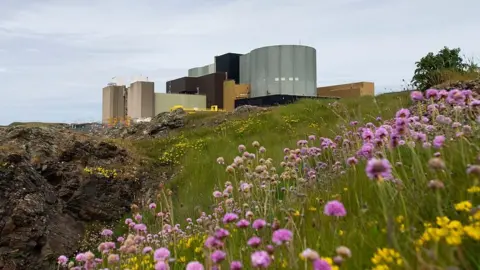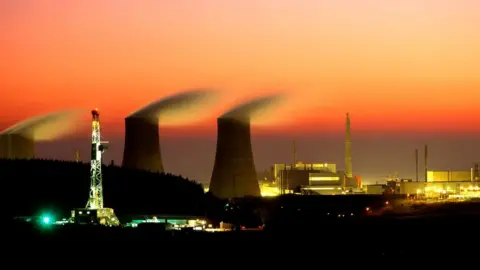Why is the government cooling on nuclear?
 Getty Images
Getty ImagesThere was a time - not so long ago - that government ministers talked enthusiastically about a new nuclear age. A fleet of brand new reactors producing reliable, low carbon electricity for decades to come. Not only that, but the government wouldn't be taking any of the risks associated with financing and building them.
Hinkley, Moorside, Wylfa, Oldbury, Bradwell and Sizewell were identified as the sites for the most significant national wave of new nuclear power construction anywhere in the world.
Of those six, only one is under construction, three have been abandoned, and two face an uphill battle to get the green light.
Under those circumstances, you might think the government would be embarrassed that its energy policy was in disarray. But it's not.
The collapse of the Wylfa and Oldbury projects today (following the abandonment of Moorside) is evidence of some new economic realities that have seen government enthusiasm for new nuclear fade.
High price
The first and most obvious is the cost of building the darn things.
At £20bn Hinkley Point is the most expensive UK construction project to date - HS2 will beat it.
The good news is that the UK government isn't paying a penny of it.
The bad news is that the electricity it will one day produce will be expensive.
EDF, the French contractor that's paying for its construction, could only raise the money to do it by extracting a guarantee from the UK government that it would receive more than double the current going rate - for 35 years.
That's one way to finance it. Let EDF raise the money and take the risk but ultimately foist the cost onto future generations of energy customers.
Who pays?
One of the reasons Hinkley is so expensive is that EDF needed to go out and borrow huge sums for a risky project at interest rates of over 9%. In fact, of the total £20bn bill for Hinkley, well over half of it was the cost of raising the money over the lifetime of the project.
 Getty Images
Getty ImagesThere are cheaper ways to finance a project like this.
The government can borrow money much more cheaply than anyone else. Right now it could get a £20bn 10-year loan at 1.3% and use that money to build the thing itself. There are financial and political problems with that.
First, it adds to the public debt - which successive recent governments have been keen to reduce.
Second, if there are massive cost overruns (and that is almost a rule with nuclear projects), the government foots the spiralling bill, taking commensurate political flak.
Third, if the government is suddenly in the business of building nuclear power stations, why not other things - in fact why not nationalise the infrastructure we have already got? That is not comfortable territory for a Conservative government.
Doing the sums
There is a another way. Pay-as-you-go. Rather than lumber future generations with more expensive energy, get current consumers to pay a little extra on their bills (amount decided by the regulator) during the construction. This removes the need for massive borrowing and means you don't have to offer a juicy price guarantee to the contractor at the end as a reward for taking the operational and financial risk.
This is the model the government now prefers and is testing on the Thames Tideway project. If Sizewell and Bradwell are ever built - this is how they will be financed.
I say "if" because the truth is, the sums for new nuclear have been made very tough by the sharp falls in the cost of renewables. In 2015, the cost of offshore wind was over £140 per megawatt hour. That makes Hinkley Point look cheap at £92.50. The price of offshore wind is now £57.50.
But hang on, says the nuclear industry. The wind doesn't always blow. When it doesn't, you will have to fire up gas or even coal stations to fill the gaps in the depths of winter. You are jeopardising our chances of meeting CO2 emissions targets and threatening security of energy supply.
The government accepts some of this, and that is why Business Secretary Greg Clark said today that he is still open to new nuclear projects. But the government's preferred direction is towards smaller reactors of the type being developed by Rolls Royce, in which the government will contribute research backing, in the hope it becomes a major new export industry.
Future calculations
The UK government is not alone in cooling on big nuclear. One of the reasons that Wylfa, Oldbury and Moorside collapsed was because the Japanese government could not get sufficiently behind the Hitachi and Toshiba projects. After the Fukushima disaster, backing nuclear power - particularly foreign nuclear power - is a pretty tough sell back home.
Whatever it does, the government doesn't feel the need to do anything very quickly. The National Infrastructure Commission has said it doesn't need to make a decision for several years yet, and the National Grid says spare energy capacity is increasing rather than decreasing. Government sources say the resilience of the system to last year's "Beast from the East" also reassured officials.
All this makes life difficult for EDF, which wants to build the follow-up to Hinkley Point at Sizewell. They will argue strenuously that only by adding a second, do you realise the economies of scale. Same design + same process + same skilled workforce + different funding model = quicker and cheaper project. Also, the more you rely on wind, the more exposed you are to its intermittence. The only way to make sure you have a secure, low carbon, reliable "base load" is to double-down on nuclear.
That argument may yet still work but it is now much, much harder to win.
